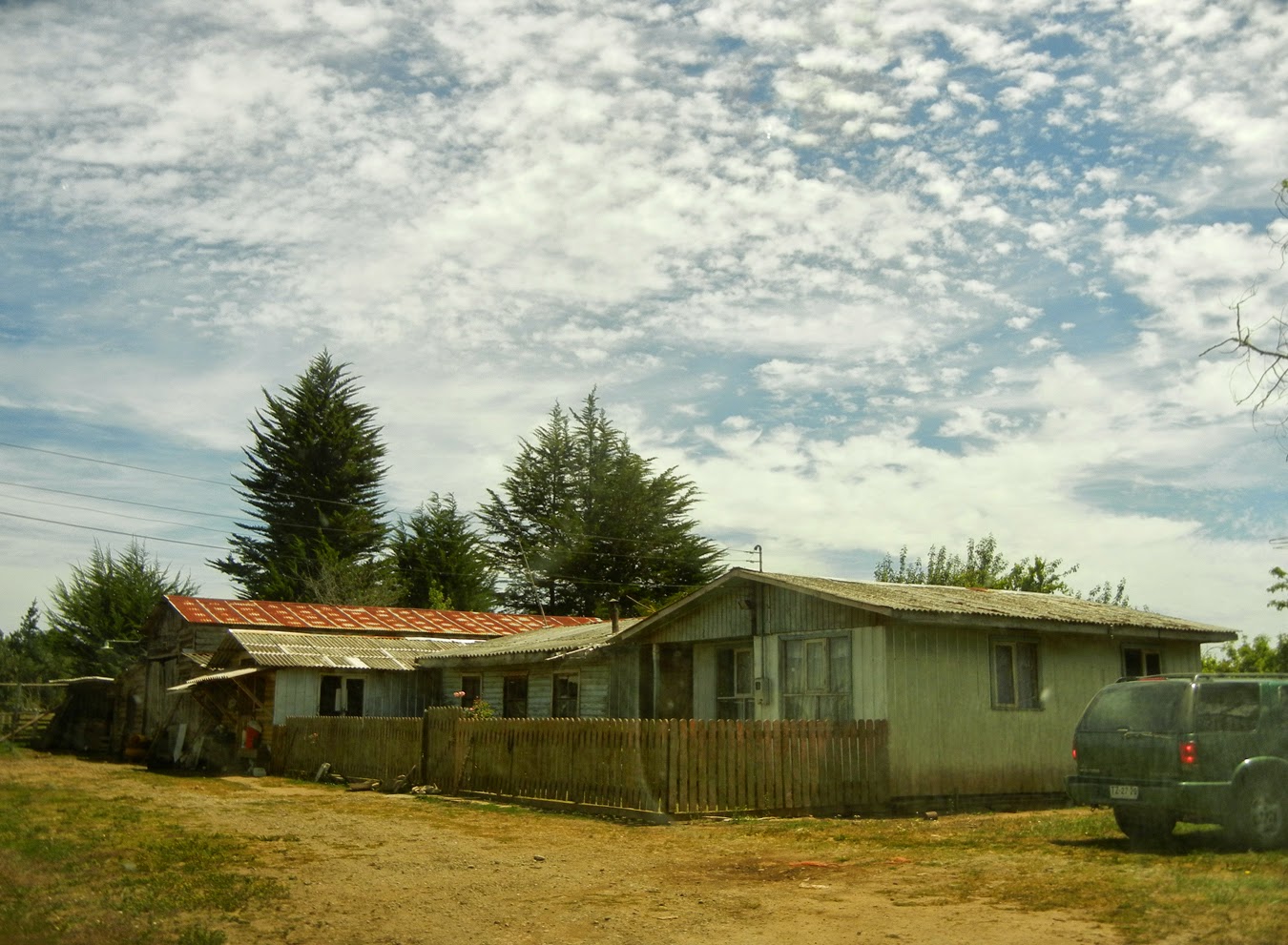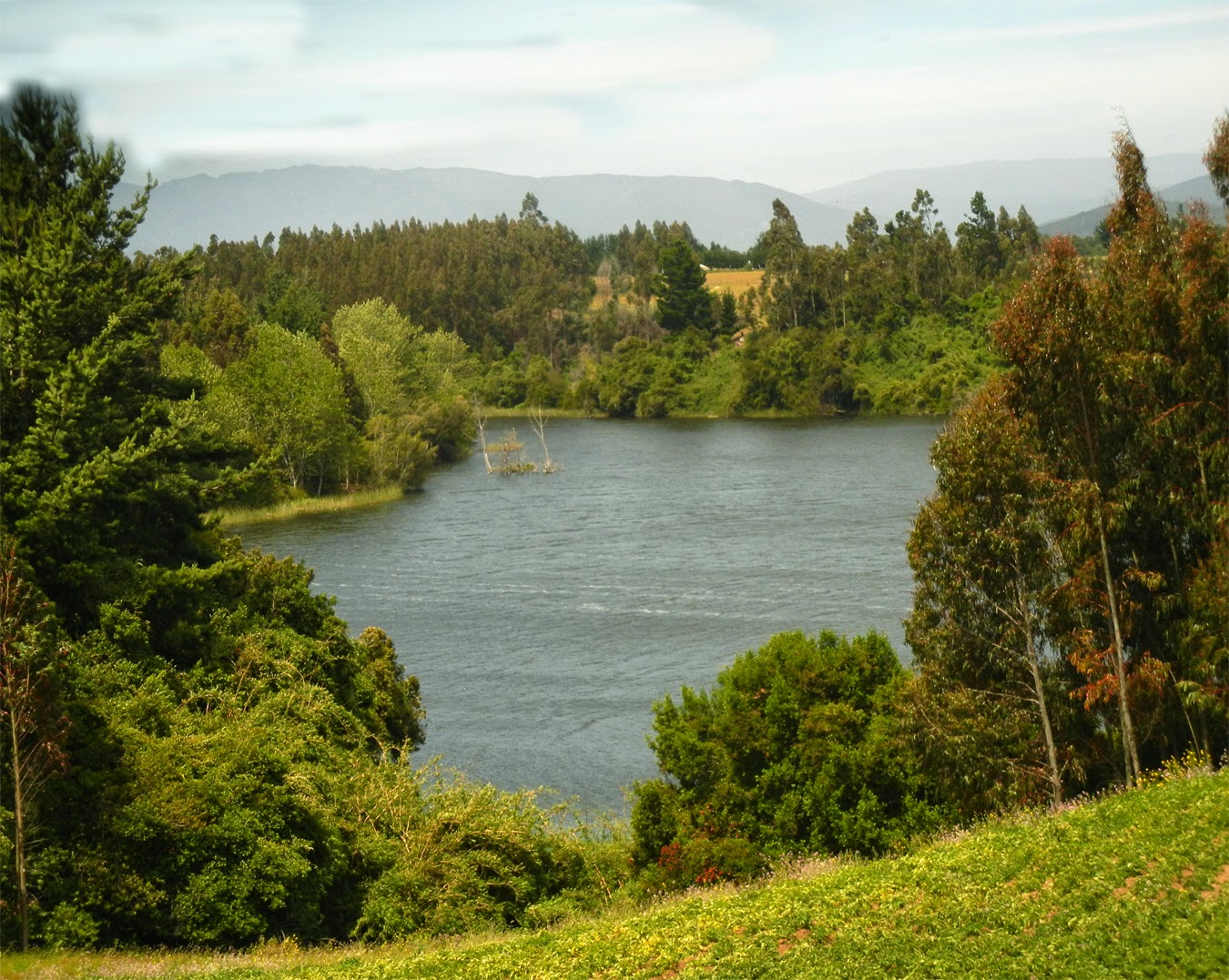The first Sunday in December we visited Barrio Boca de la Costa in San Pedro de la Paz, where the Bio Bio River meets the Pacific Ocean.
The ward was large, active, and well-run.
Following church, we picked up Andrea and Manuel for a visit to Cañete, south of Arauco. We stopped in Coronel to pick up Manolito at Andrea's mother's house. The Rodriguez home was built by the government following the 2010 earthquake.
Andrea's mother and her uncle, who is blind.
Driving south, passing more pastures of grazing cattle.
The road was well-engineered, and on Sunday afternoon, fairly empty. We made it to the outskirts of Cañete in good time.
Cañete is not far from the epicenter of Chile's 1960 record-shattering 9.5 earthquake in Valdivia. The Chilean government has built many replacement houses, including this one, where Gisela and Marcelo live.
Gisela lived with and became very close to Andrea and Manuel while she was studying Restaurant and Hotel Management in Concepción. Since she and Marcelo are getting married in February, and we were willing to stay in the Hostel in Cañete, they offered their home instead as a bed and breakfast, even though they slept themselves at Gisela's mother's house. The amount we would have paid to a Hostel would mean a lot to them. It sounded like a good arrangement to us.
Gisela turned out to be an outstanding cook. For desayuno, breakfast, she made sopaipillas and pan de campo, homemade bread, with paltas - avocado, scrambled eggs, sliced cheese, and juice. For our Monday almuerzo, she served us an excellent salad with home-grown greens, beans, sweet corn, and tuna; papas puree - mashed home-grown potatoes - with pino, the typical Chilean ground beef-onion-cheese-hard boiled egg mixture; and creme caramel, a flan made with caramelo, caramelized sugar syrup. It was all excellent, worthy of a fine restaurant, and served on Gisela's pretty dishes.
After lunch, we followed Gisela and Marcelo to where Marcelo's family owns a fair amount of land - about 70 hectares, or 175 acres - between two lagunas. It was on the other side of Cañete, known as a historical town because of the battles which took place between the Spanish conquistadores and the Mapuche defenders.
We passed many forests of eucalyptus, which drive out other growth and take up a lot of water through their root systems. These fields were bought from the original Mapuche owners - unhappily, in the minds of many - by the Chinese, who value the eucalyptus for its wood. Disagreements over land ownership and the maintenance of native forests has led, in some areas, to violence.
Cañete's hospital complex, with its interesting round buildings which pay homage to the Mapuche thatch roof dwellings called Ruka.
Down the main boulevard are these stylized representations of the Araucaria Araucana, the monkey-puzzle tree, sacred to the Mapuche Indians.
The Mapuche museum was, unfortunately, closed on Monday.
In the Mapuche Plaza Caupolican were more Chemamüll, Gente de Madera, wooden people, like the ones we saw in Temuco. The wooden people are carved from single hardwood logs and stand next to a deceased person during the funeral, and then as a marker over the grave. Their purpose is to help the deceased reunite with their ancestors. The Spanish considered them idolatrous and destroyed many. The marker in front mentions Marcelo's uncle as one of the men responsible for building the memorial plaza.
Next we went to Fuerte Tucapel, the fort where Pedro de Valdivia, the first royal Spanish governor of Chile, was killed in 1553 in a battle with Lautaro and Caupolican, the fierce Mapuche warriors and their armies. This was in spite of Valdivia's attempts to repair relations between the Mapuche after their maltreatment at the hands of the first Spanish explorer of Chile, Diego de Almagro.
One of several cannon used by the Spaniards to defend the fort, which overlooks a valley. Next to Elder K. is Marcelo, a Mapuche, who, we discovered, is very steady, hard working, and kind.
The valley in which the battles took place.
Gisela and Andrea knew of some artesanal Chilean shops, and that I wouldn't be able to resist.
Lana, wool yarn, in natural colors. The pink is dyed using mora, blackberries. Elder K. picked out the basket.
We drove several miles along a gravel road, catching our first glimpse of one of the lagunas.
Marcelo's parents' home on the farm. Electricity was finally installed several years ago, and they built a working bathroom, but there is no hot water in the house, and only two faucets.
In the yard a family of patos - ducks - was running around.
Also pavos, turkeys, which actually do make that ridiculous gobble-gobble sound.
The home is built near the shores of one of the lagunas, which is owned by the extended family. It has a subterranean water source.
Gisela, Marcelo, and Manuel Mendoza. Gisela is the only member of her family to be baptized a member of the LDS church, and Marcelo has started accompanying her to church services.
Elder K. and I. We are finally getting a little color in our faces after the winter.
Next, we drove along the gravel to where Marcelo and his father needed to fill an order for the delicious red potatoes they grow in one of their fields. When I turned around, Elder K. had ahold of another woman's hand, which is not all that unusual. All the land and the lagunas are owned by Marcelo's Mapuche mother and her family.
Harvesting potatoes to fill six 50-kilo (110 lb.) bags took the better part of two hours. It was nice to get dirty again. Elder K. was thinking about how helpful a tractor would be about now. The family borrows the use of a tractor now and then, but a lot of the work is done by hand, and many of the fields lie fallow because there aren't enough workers or capital to run them.
I found a knife and a pair of scissors so Andrea and I could harvest a patch of Hierba San Juan, St. John's herb, which Hermana Rosa uses for one of her skin creams.
Joint-stemmed limpia plata or cola del caballo, clean silver or horsetail, is an herb used for its antiseptic, diuretic and anti-inflammatory properties, for respiratory problems and sore throats.
I followed Andrea and the abuelita, Marcelo's mother, down to the other laguna, where she has her vegetable garden. Although the surroundings are beautiful, life has not been easy. The abuelita told us of carrying one of her guaguas - babes in arms - three hours as she walked to town when the baby was sick and her husband away, and the baby not surviving.
The view of the unspoiled, private laguna. Several of Gisela's relatives showed up to go fishing. We thought maybe we could build a little cabin here, and no one would ever be able to find us.
A white garceta, egret, flying over the water.
Blossoming mora, blackberries.
Hortensias, hydrangeas about to bloom next to the old dock house.
The huerta, market garden, where the abuelita grows vegetables on a fairly steep slope alongside the sauces - willows, and abedules - birch trees.
Lettuce and cilantro seedlings. When the potato sacks were filled, including one for the Mendozas, we went back to the house and cleaned ourselves up. Marcelo's father approached Elder K. several times about buying our Subaru Outback when we leave Chile. We said our goodbyes, promised to come back for the wedding, and headed back toward Concepción.



































No comments:
Post a Comment
Note: Only a member of this blog may post a comment.